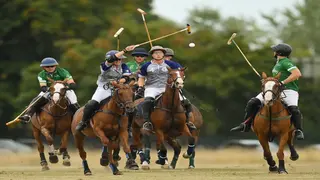Inter Milan players' wives and girlfriends in 2024 with photos
Football
Aikido is a popular martial art in Japan that involves different techniques. It resembles jujitsu and judo but differs from karate, which has spread in most parts of the globe. Anyone can learn Aikido techniques and tactics from wherever they are.

Aikido means 'The way of unifying with life energy' or 'The way of harmonious spirit'. It is a Japanese style that focuses on controlling and redirecting the force and momentum of an attack. The martial art utilizes techniques like throws and joint locks.
The martial art focuses on self-defence rather than attack mechanisms. It aims at turning an attacker's strength and momentum against them. Morihei Ueshiba founded Aikido in the early twentieth century. Ueshiba was born in Japan on 14 December 1883.
Ueshiba, commonly called O-Sensei, or 'venerable teacher', created the modern Aikido by combining his martial training with his religious and political ideologies. He believed it was a path for self-development that anyone could learn aikido skills and techniques.
Inter Milan players' wives and girlfriends in 2024 with photos
Football

Aikido was spread from Japan to the rest of the world in the 1950's. Learners wear unique uniforms called aikidogi and hakima pants during training.
The martial art has over 10,000 techniques, but we will highlight the six basic ones and the most deadly moves to avoid. Aikido's all techniques have six pillars, namely, osae waza (ground control), shihonage (four-directions throw), iriminage (entering body throw), kokyunage (breath throw), kaitennage (wheel throw), and ushiro (behind back).

There are different types of aikido techniques for beginners and advanced learners. Let us sample the six basic aikido techniques step by step and how to approach them.
Ikkyo is an entrance move for styles like nikyo, sankyo, yonkyo, gokyo and hijikime osae. It involves holding the attacker's hand by the elbow with one hand and the elbow with another while applying pressure to the wrist and throwing it to the ground.
Takehiro Tomiyasu's salary, contract dating, net worth, age, stats, and more
Football
Nikyo is the second teaching and a painful technique for the opponent. It involves grabbing the attacker's arm, pulling it down, twisting it, and pulling it downwards. You must apply pressure on the wrist while twisting it backwards.

The third teaching is a rotational wristlock that directs upward-spiralling tension throughout the arm, elbow and shoulder. The Sankyo technique contains a painful wrist twist if done with too much force. One should learn to control the attacker's body while twisting the arm to avoid inducing pain.
Yonkyo or Tekubi-Osae (wrist securing) helps to attack the opponent's weak points. One must first find the opponent's weak point in their arm and apply pressure to control their radial nerve and cause them pain. Through the pain, it is easy to contain the attacker.
Mateo Kovačić's net worth, house, cars, contract, dating, salary, age, stats
Football
Gokyo is a basic elbow control technique of removing a knife or tanto from an attacker's hand. The approach involves grabbing the opponent's arm firmly from underneath, with both arms, then rotating it to bend and lock the elbow. Ensure one of your hands is closed on the elbow while the other turns their wrist backwards.
Rokkyo is also an essential technique commonly used to disarm the opponent. It is also called Hiji Kime Osae or "Elbow Arm Bar Pressure". Rokkyo involves rotating the opponent's extended arm and putting pressure on them.

Although Aikido is a non-violent martial art that focuses on neutralizing the opponent, some techniques, like Sankyo, can cause significant damage if executed improperly or with excessive force. Other deadly Aikido attack techniques include:
Fikayo Tomori's salary, contract, house, cars, net worth, age, stats, latest news
Football
The technique allows you to use your hip to throw an attacker to the ground. When landing, the opponent may break their bones, causing head trauma or internal injuries. To avoid the deadly impact, one should execute the throw with caution.
Striking an opponent from behind when they least expect is dangerous. It could cause damage to their head and neck, leading to concussion or other serious injuries. Ushiro-ate could also knock the attacker unconscious.
The approach can cause an attacker's shoulder to dislocate when executed with enough force. It could also cause severe damage to the shoulder joint and surrounding tissues.
The Aikido strike can knock out an opponent in seconds. Shomen-ate involves striking an attacker's nose or chin with the heel of the hand or forearm. The move can cause a concussion or knockout to the attacker.
Ranking the 10 best attacking trios in football history
Football

The martial art uses three primary weapons for training. They are the wooden tanto, the jo staff, and the bokken sword. Most Aikido practitioners learn how to use the equipment to neutralize their opponents.
The tanto is a Japanese short sword or dagger with a blade of varying length, often used by the Samurai. Its original version had a single-edged knife and a curved shape. Tanto's styles and uses differ by blade shape.
Jo is a cylindrical or octagonal straight wooden stick of varying lengths. Most martial artists prefer it because of its elegance and simplicity. Ueshiba adopted the jo to teach aikido principles. The weapon's history dates back to 1608 and 1611, during a battle between Samurai Muso Gonnosuke and Japan's greatest swordsman, Miyamoto Musashi.
The bokken is a Japanese wooden sword used as a safe substitute for a real sword in several martial arts training classes. Masters used the sword to train warriors and samurai in ancient days.
Who are the most famous mountain climbers in the world right now?
Other Sports

The martial art is known for its defensive techniques and philosophy of peace and harmony. However, it is ineffective in street fights or real-life battles since its goal is to defend yourself rather than attack. Some people also consider it a soft martial art compared to others.
The technique can cost you since the opponent always tries to hurt you. Therefore, you will need to use different techniques from other martial arts, like karate, muay thai and kickboxing to stand a chance of winning the fight.
Aikido's popularity grew significantly when Steven Seagal, an Aikido learner, became an action star by applying its techniques in his action scenes. Seagal became the first foreigner to run an Aikido dojo in Japan. He successfully used the skill to overcome his opponents in films.
Learners progress by promotion through grades (Kyu), followed by degrees (dan). Most Aikido organizations use different belts to distinguish the learners' grades. The colours vary depending on someone's level. Here is a breakdown of a grading system used in an organization, from the list to the highest ranking.
Who are the most famous horse polo players ever? A list of the top 10 horse polo players
Other Sports
Ungraded | White belt | No badge |
6th Kyu | White belt | Club badge |
5th Kyu | Yellow belt | - |
4th Kyu | Orange belt | - |
3rd Kyu | Green belt | - |
2nd Kyu | Blue belt | - |
1st Kyu | Brown belt | - |
1st Dan | Back belt | - |
Learning Aikido techniques could take several years, depending on someone's mindset and technical and physical proficiency. It could take around two years to learn the basics and about eight years to become a professional by rising through the various belt ranks.
READ ALSO: Which are the 10 rarest Air Jordans in the world currently?
Sports Brief also listed the ten rarest Air Jordans in the market as of 2023. Michael Jordan's sneakers are among the most coveted shoe brands globally, following their rarity and immense value. Most enthusiasts and collectors often go to great lengths to acquire these pairs of shoes.
Nike produces the Air Jordan sneakers for the five-time MVP. Follow the above link to discover some of the rarest shows in the brand and why people love them.